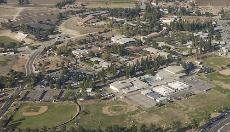Kelly Goff and Gil Riego, Jr.
Begun as a place for former World War II GIs to retrain for domestic jobs, Pierce College has evolved into a multi-cultured, multi-ethnic student body. While still maintaining an agriculture and pre-vet program, the curriculum has vastly expanded. As the campus marks 60 years, it is again in the midst of change, growth and renovation. Here is a look at where it’s been and where we are headed.
Imagine an all-male, residential campus where agriculture and animal sciences are the primary academics.
Thinking of a small farm school, with cowboys and rodeos out in the middle of nowhere?
Then you are imagining the early stages of what would become Los Angeles Pierce College.
Formed primarily to re-train World War II GIs after the war, the Clarence W. Pierce School of Agriculture, as it was originally called, was located in a San Fernando Valley with a drastically different landscape than the urban setting of today’s school.
Set amid orange groves and open land, the school did not have any main roads connecting it to Los Angeles and no freeways.
Early teacher Eugene Dow was in the habit of bringing an extra set of clothes to school when it rained, just in case he got rained in, according to his widow, Ellen.
Students lived in dormitories that now house faculty offices next to the Freudian Sip. If you go in and take a look, you can see the urinals and showers, remnants certainly out of place on today’s commuter campus.
Slowly, the focus of the campus shifted as the Valley was slowly developed. With the 101 freeway came a growing population, and with that population came an urban setting, with Pierce’s 426 acres a unique remaining respite from the noise and the smog.
Curriculum shifted from the East Campus farm (pictured above) to the still-developing West Campus Village (in foreground of photo at left.)
With nursing, business and auto classes replacing the early farm techniques as prized knowledge for today’s job market, administrators are now looking for ways to prepare Pierce for the next major shift.
President Robert Garber talked recently about integrating the idea of environmentally-friendly buildings into the current construction plan, and mentioned adding teaching about hybrid vehicles and green techniques to the autotech and electronics course offerings.
“We took the initiative… let’s look at what we need for 2010, 2015. We are going to integrate technology, workforce development and environmental issues.”
“The current construction plan will most likely be completed in the 2009 or 2010 school year, maybe a little more,” said Garber.
“We have to do our part to plan for and to strengthen our workforce development, and this is where those things are headed,” he noted.
One of the largest construction undertakings on the campus in decades will be the new Center for the Sciences, which will solidify Pierce’s dedication to future students, and the building, Garber notes, will incorporate “green” elements.
He also envisions the art hill framed by a green technologies building and a digital arts building.
All of this construction is in anticipation of the continuing growth of the student body, which this semester rose above 21,000 students, from the 67 students when the college began 60 years ago.

The farm area of campus, with the war-era Quonset hut at the left side, circa 1950s. That area is now home to the equestrian center. ()

Aerial photo by Adrian Sanchez-Gonzalez, with assistance from Norman Schwartz (Adrian Sanchez-Gonzalez)


